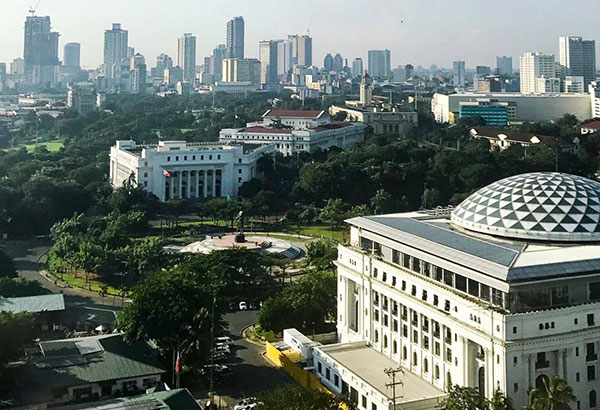Now, there are more reasons to visit Manila


The new National Museum of Natural History, which opens this month, as seen from Waterfront Manila Pavilion. The hotel is walking distance to Manila’s historical attractions, such as Intramuros, Fort Santiago and the Museum of the Filipino People and National Art Gallery. Photo by Tanya Lara
For 27 years, Travel Time host Susan Calo-Medina ended her TV show by telling Filipinos to “not be strangers in their own land.” The beloved host, who died two years ago, encouraged Filipinos to explore the country’s islands and provinces.
Millions of Filipinos did take her advice as destinations previously unheard of, like small coastal towns and “undiscovered” islands, have become popular in the past years.
But one thing a lot of us travelers seem to have forgotten is to explore our capital city. Now, there are more reasons to explore Manila with the opening of the National Museum of Natural History. The new museum completes the trifecta of cultural destinations about our country and people.
The new museum is just across the Museum of the Filipino People, which formerly housed the Department of Finance, and the National Art Gallery, which used to be the Senate Building.
Within the same neighborhood is Waterfront Manila Pavilion, a hotel that boasts being a witness to the changes in the city’s political, cultural and built landscape since 1967, when it opened as Manila Hilton International.
A four-star, mid-market hotel, Manila Pavilion this year completed its renovation to attract locals and tourists who want to make Manila their base.
General manager Jean Francois Asimus, who has managed luxury hotels here and abroad before Pavilion, says there is a unique responsibility in looking after a pioneering hotel that has been around for the past 50 years. “Plus the location is really special,” he says. “Manila has so much to offer and we’re in the perfect place to cater to guests who want to get to know the city.”
The hotel has 274 deluxe, deluxe premium and premier rooms; 8 premier suites;18 executive suites, 3 family rooms; 26 Ambassador rooms and 4 Ambassador suites; and 2 presidential suites.
The renovation brings the interiors up to date with bright walls and earth tones, and splashes of red, yellow and blue in the rooms. The rooms also feature 40-inch flatscreen LED TVs, iPhone and iPod docks with radio and WiFi access.
The Ambassador Club Lounge is now equipped with a computer work area, a business center and a boardroom for six people.
Two suites that are designed similarly are named after historical figures: the Aquino suite and Romulo suite. The former has touches of yellow and the latter blue. They both feature a sitting area for guests, a bedroom, a dining room with kitchenette, and a bathroom with a tub.
The renovation has also been completed for the hotel’s ballroom and function rooms, which are popular for business seminars and lifestyle events, and Seasons restaurant, which offers classic European and Filipino favorites, and coffee shop Patisserie, famous for its ensaymada.
Located at the historical downtown and business district of the capital, the hotel is truly “at the center of it all,” with Intramuros being walking distance.
At a media event in August, we took advantage of this location with a walking tour in Intramuros — and there is always something new to discover in the Walled City.
We started at Baluarte de San Diego, which dates back to the 16th century and whose construction was headed by Jesuit priest Antonio Sedeno. The bastion, part of the fortifications of the walled city, was originally named Señora de Guia or Our Lady of Guidance.
Fort Santiago, a citadel built by Miguel Lopez de Legazpi in1571, was recently renovated — much to the dismay of everyone who has been there before. What used to be lush gardens with shade trees are now concrete and pavers. Still, Fort Santiago shouldn’t be missed. This was where Dr. Jose Rizal was incarcerated before he was executed in Bagumbayan and in his cell here, he wrote his literary masterpiece “Mi Ultimo Adios” (“My Last Goodbye”).
And then there’s San Agustin Church and Casa Manila. The church was the first built by the Spaniards in Luzon after relocating the capital from Cebu. It contains the tombs of Spanish conquistadores as well as a museum containing stunning artifacts from vestments to religious icons and scriptures.
Casa Manila, a reconstructed Spanish-period house, is a replica of a Spanish house that once stood along Calle de Jaboneros in San Nicolas, Binondo. It’s a glimpse into the 19th-century domestic life of an affluent family in Manila. The furniture, the wall coverings and accessories all speak of a time when life was different, perhaps simpler, when the rich lived not too differently from ordinary folks.
As the song says, we keep coming back to Manila. And now is the best time for one more visit.
* * *
Visit the author’s travel blog at www.findingmyway.net. Follow her in Twitter and Instagram @iamtanyalara.
Waterfront Manila Pavilion is located at UN Ave. corner Maria Orosa St., Ermita, Manila. Log on to www.waterfronthotels.com.ph.


















